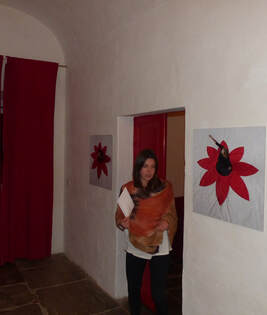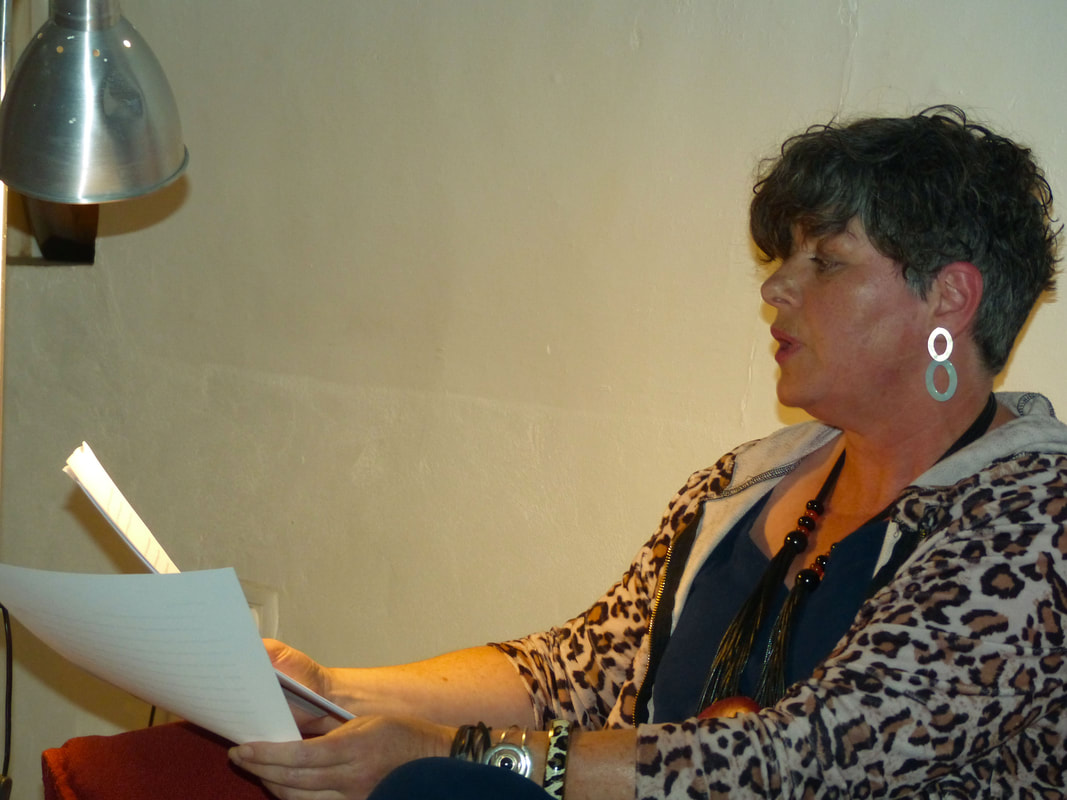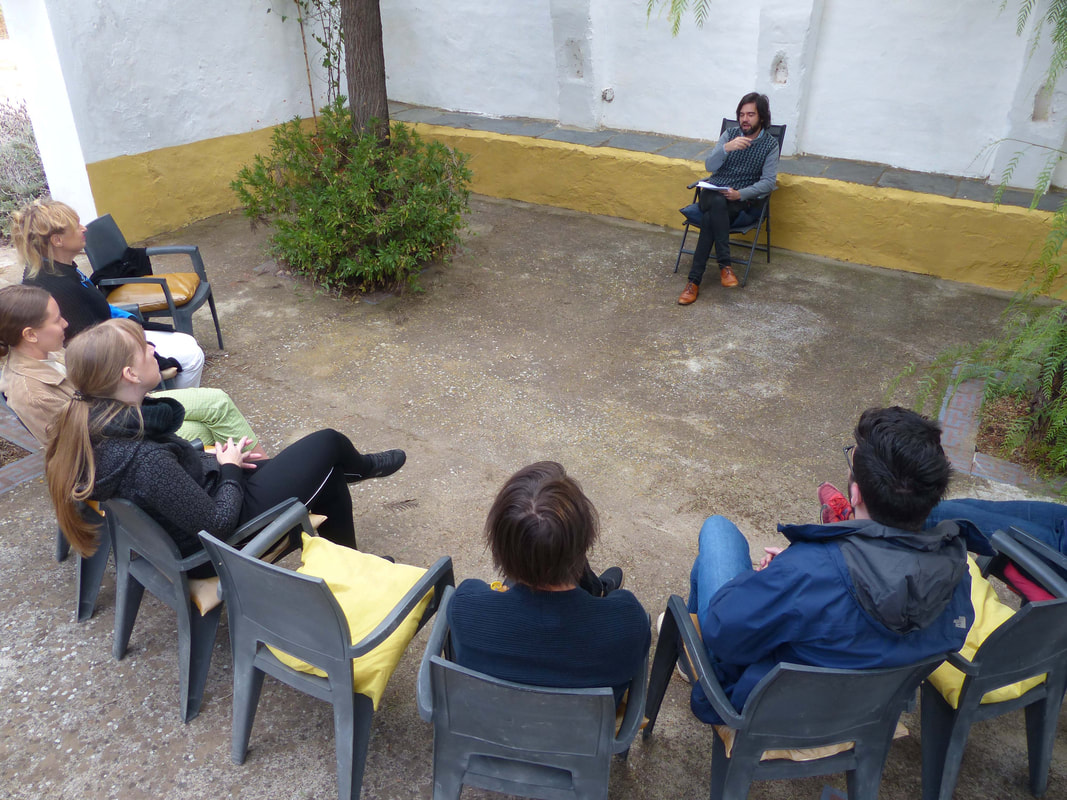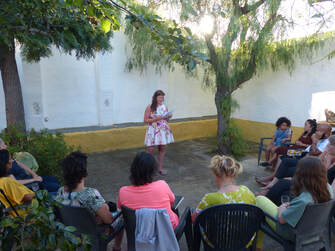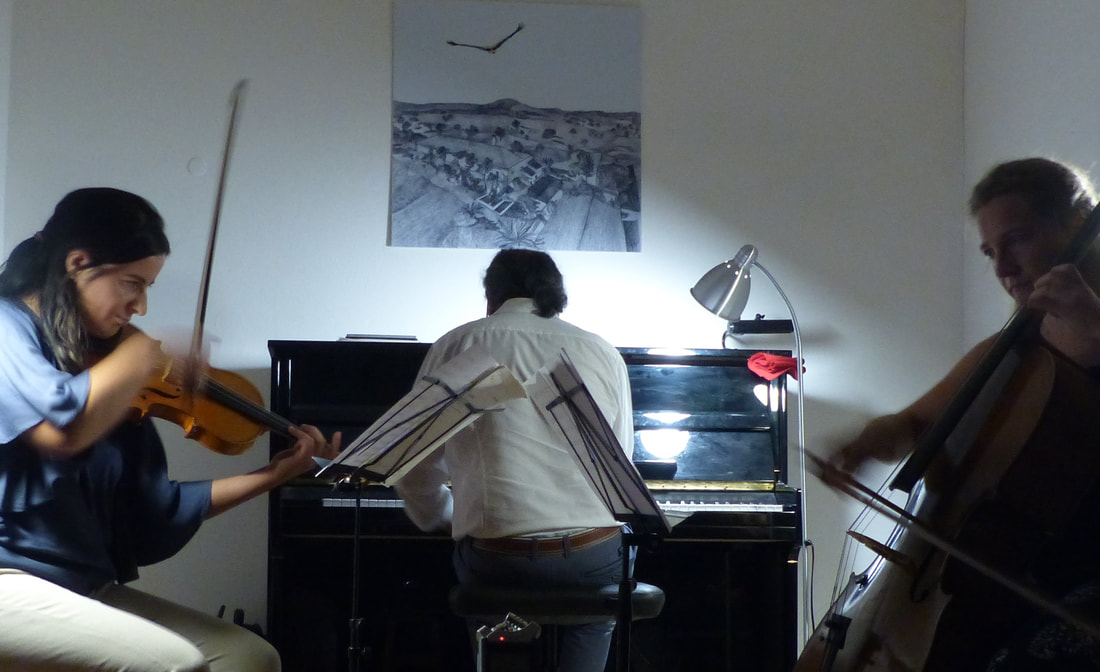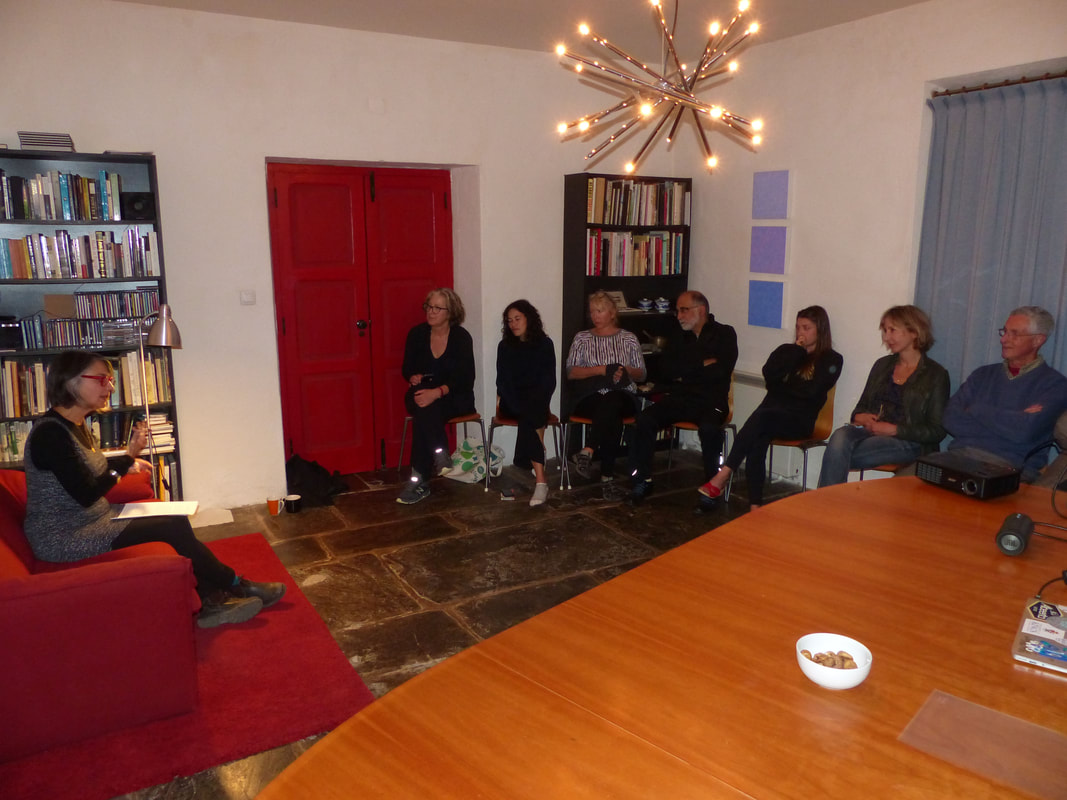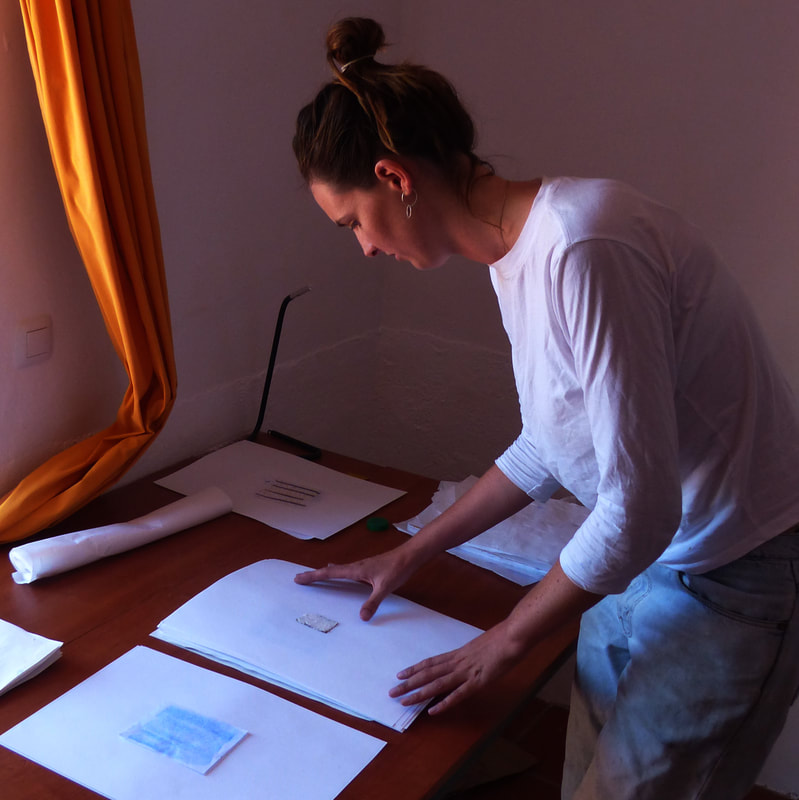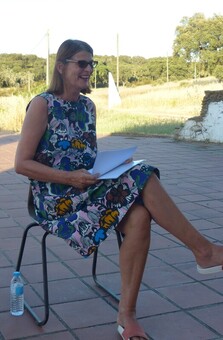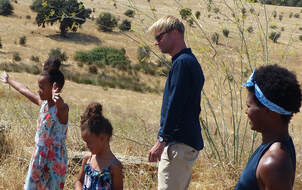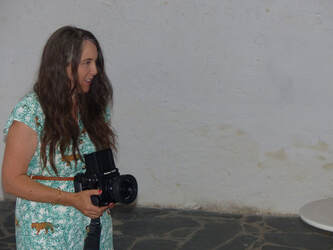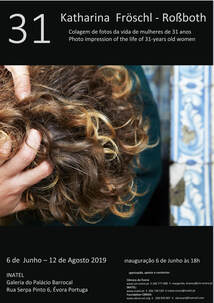This page shows residents and their projects in 2019.
Other pages show residents and their projects in 2018, 2017, 2016, 2015, 2014 , 2012 and 2013 and 2004-2011.
A visual collage of residents is in this slide show.
Other pages show residents and their projects in 2018, 2017, 2016, 2015, 2014 , 2012 and 2013 and 2004-2011.
A visual collage of residents is in this slide show.
|
Maria Hannson (Sweden) is singer and performative artist. “Natural Opera” was the title her project. She came to OBRAS to explore her voice: to go beyond singing genres and find her expression in the performative arts. Maria brought several masks to perform with. The mask changes the perception of the voice, both for the audience and for herself. She showed this in a short performance in the hallway of our house.
Maria got some unique experiences. One was singing while (voluntarily) been locked up in the fortress of Evoramonte. But most were in abandoned marble quarries. In two she danced, partly in the water and in another she had a photo shoot with Pedro Ferro. Almost certainly these experiences will have follow ups in Sweden or elsewhere. Sarah Millar (UK) was working on a book with narrative non-fiction stories with many autobiographical details. The book's structure has four elements: character/setting/theme/conflict and are woven together by the narrator´s inner dialogue. Sarah impressed everybody at her reading, both because her personal story is far from mainstream and because her style and wording are original and swinging: conscious prose poetry, she named her style.
On 27 September we got a spectacular performance by Gwenn Sampé. It was the start of an evening full of music and poetry.
With the enormous reach of her voice Gwenn was singing and telling about fears for ourselves and for the other. Her melodies were jazzy, sometimes interrupted by screaming, whispering a lullaby or singing a swinging gospel. There were several other performers of that evening. Eilleen Kaene did sing Irish, English and Spanish folk songs, written by herself. Stella Whalley had an open studio showing the work that she made at OBRAS. José Rodriguez did sing two cantas Alentejanas and presented a poetry project involving ten languages (see below). Maria Hannson gave a musical performance with a wooden mask. Fernando Costa showed his latest wood carving and did sing, accompanying himself on a special guitar: viola Portuguesa. Hermínia Costa recited two of her poems and did sing several times during the evening. And Hermínia and Fernando cooked a traditional Portuguese dish: porco preto com migas de espargos. On that evening our friend José Rodriguez dos Santos (Portugal) presented his poetry project "Found in Translation”. Some time ago he wrote a short poem in German and translated it with Google Translate in another language. Then he had the translation translated in a third language and so on until the poem was translated ten times, the last one being in German. He repeated this circle of computer translations three times. The original poem disappeared completely, but the translations brought unintended information to the surface; a revelation, created by a machine, that was hidden in the original poem. “This is very similar to how I create my abstract paintings: I try to create with no intentions”, Victoria Cattoni said.
Eileen Keane (Ireland) is a multi-talent: singer-songwriter, performer, poet and writer. She did sing for us in several occasions and impressed us deeply. But she came to OBRAS to write on her novel/memoir, covering the first 30 years of her life. It is a life full of drama, tragedy, adventure and love. During her reading she showed her talents as a performer (she is considering to make an audio version of her novel).
Jona Ray (India) wrote poems on historical or societal issues, sometimes charming, more often heavy, but always in the words of voice-less people: an over-worried father influencing family life even after his death, the fate of spouses of defeated heroes, holocaust victims pushed in trains to a concentration camp, ...
During her artist talk Jona was reading out some of her poems with musical intervals with compositions of Tetsuya Hori, a fellow resident. All of us were moved. After her return to India she wrote a nice essay on her residency in an indian newspaper. On 6 June we had the opening of two exhibitions in the Gallery of INATEL in Évora (see newsletter). This opening was highlighted by an impressive performance by Phyllis Akinyi (dance) and Stephan Jarl (percussion).
Phyllis started her performance by walking through the two exhibitions and continued on a stage together with Stefan Jarl in the patio of the Palacio Barocal (Evora). The performance deals with identity, cultural roots and tradition, but also refers to the liberation of the feminine. Phyllis is a Danish / Kenyan performer who works mainly as flamenco dancer in Scandinavia and Spain. In this performance she mixed flamenco with Scandinavian post-modernity and Kenyan ritual dance. Ingrid Simons, painter from Holland, came back for her tenth residency! This time it was for two months and it became may be the most productive residency until now. The slideshow gives an impression. Ingrid paints half-abstract landscapes and she is increasingly successful and renown. In most recent years she is making a big shift: from interpreting the landscape she is experiencing the landscape. José Rodrigues dos Santos, a Portuguese friend is writing an essay on Ingrid’s work, and on contemporary landscape painting in general. During the Open Studio on 26 June he told about his vision and all were impressed. Ingrid is invited by the Estremoz Museum to have an exhibition in spring 2020 in the beautiful Dom Dinis Gallery.
Simon Frisch (USA) was working on a music composition entitled J'AY LE CORPS DÉLIÉ. It is a song-cycle-as-fable that revisits the Duchess Anne de Bretagne's legendary forty-day funeral (1514). Her forced marriage to the French crown in 1491 marked the end of Breton independence and the beginning of a power struggle that still lives in the current Breton consciousness. Drawing on original texts and from her court and from contemporary Breton writers, Simon´s song cycle frames earthly and spiritual dimensions of Anne's transformation and questions how the physical body transcends to symbol. Simon´s compositions are contemporary but clearly refer to medieval and renaissance polyphonic singing.
With the support of Steven Fox and the Clarion Orchestra and Choir, Simon got the opportunity to realize this story for presentation at the Cloisters in Manhattan. Maude Deslauriers (Canada) was doing a residency in the scope of her Masters degree in Fine Arts.
Maude´s work acts as a reinterpretation of botany. She observed that in traditional taxonomy illustrations often show similarities with human organs and especially female genitals. Maude is bringing this in the scope of feminism. She used mediums of traditional botanical illustration such as watercolour and gouache to create half abstract images with suggestions towards nature and the human body. Bel Falleiros (Brazil, living in the USA) was working on a long-term project on the phenomenon of monuments in public space. She was focussing on Pelourinhos. These are columns, often made of marble, and most of the time placed on a public square. It was the location where justice was spoken and where punishments were executed. The Portuguese brought this custom to Brazil, where it stepwise became the symbol of oppression of the native Indians and especially the slaves by the colonisers. That is why in Brazil they virtually all have been destroyed in the post-colonial time. In Portugal they do not have this connotation and are valued as a historical object, causing odd feelings by Brazilian visitors.
Bel did several side-project using local marble and clay. Among others she made an installation that referred to the megalithic monuments in the region. Geoffrey Stone (USA) was working on his second novel that tells the history of a family in the nineteenth century that tried to emigrate from Portugal to the USA, but was not accepted and ended up in São Paulo, Brazil. The story also traces back family traditions and the origin of the family name. But it may also tell about people whose dream does not come true but nevertheless does not get frustrated but enjoy the second best.
Diane O´Dwyer (Australia) returned for a residency at OBRAS-Holland. Her main focus was papermaking and printmaking. She explored what is happening to the land and environment due to both our daily life decisions as well as climate change. Diane continued her collaboration with Bert Hoekstra. He is a Renkum-based artist and specialist in papermaking. They together explored new surfaces to paint and print on.
Sherry Wiggins (USA) returned to OBRAS-Portugal for a short but very productive residency. Together with the Portuguese photographer Luis Branco she did photo shoots in the fortress of Evoramonte, in the nature directly around our house and Pego do Sino, a hidden canyon on a 30 minutes’ walk from the house. An impression is in the slide show on this page and much more about the results and vision is on the blog of Sherry. We have started preparing a duo exhibition for Sherry and Luís in the prestigious Salão Nobre in the Palácio Barrocal in Évora in spring next year.
The work of Sherry and Luís of 2017 has been exhibited earlier this year in Denver, Colorado. Sherry and Luís have a long term project: a contemplation on human/nature relations, dedicated to nature embracing a middle aged woman.Although Sherry is the model and Luís the photographer, it became an intense exchange of creative ideas. In OBRAS-Holland Derek Cracco (USA) made some abstract works that remind to planetary systems or eyeballs. And he started a body of work related to America’s obsession with guns and how the media has glorified and promoted this obsession. By drawing, painting and reworking found images he created devotional prayer cards for the holy cult of the Second Amendment. Both heroes (Rambo, Bruce Willis, ..) and martyrs (victims of mass shootings) are figuring. He studied the iconography of 14 to 17 century Flemish paintings in the Dutch museums to suggest the cult of the gun to be a religion.
The French sound-artist Frederique Mathevet amazed all of us with his artist talk. A major part of his project was basically making sound compositions of images from objects in the surroundings. He outlined the piano keys on a transparent sheet and moved this sheet over the objects. The overlap of a piano key on the sheet with a line of dot in the object resulted in the base for scores for a piano composition. It was a highly original and fascinating example of cross-art. Have a look at the slide show.
Anna Ortiz (USA) has a Mexican father. Step-wise she is more and more using her Mexican roots as a source of inspiration for her paintings. During her residency she completely focused on it, resulting in a fascinating series of drawings and paintings with hints to Mexican mythology or with surrealistic scenes with a Mexican touch. One painting shows Flor, our one-eyed cat, as an Aztec God.
Anna showed her recent "Portuguese" works in an exhibition: Ruin, in the Royal Society of American Art, Brooklyn, USA (July-August 2019). The cellist Beate Schnaithmann (Germany, living in Switzerland) had an intense residency. She was studying many hours per day, but also started a series of collaborative projects. Most of them are mentioned elsewhere in this newsletter. With Rob Monaghan she went at night to the marble quarries to make video and sound recordings with just the sound of the cello, moonlight and croaking frogs. Later at daylight she played Benjamin Britten at a lake in a marble quarry. Initiated by Carolyn Wenning she did a cross art project in which visual artists responded on her improvisations. And with Ingrid Simons she responded with cello sounds on Ingrid´s video of a seascape. Most remarkable is that she started a trio with Mauro Dilemma (piano) and Andreia Vaz (violin). They almost certainly will have concerts in the near future in Portugal and Switzerland. But above all the residency brought her new viewpoints and inspiration for her musical career.
Jane Flett (Scotland, living in Berlin) worked on a novel, partly built up of hundred-words fables. The novel is basically an epic longform poem about a girl who gets lost in the wilderness. It is inspired by Scottish myths but also on people who are lost during nature trials. The story explores the point that a desire to get away turns into a terror once it actually happens. It tells about disintegration of perception and loss of sense of self that occurs when you no longer have the grounding of knowing where you are.
In addition she made short poems. One is a highly original vision on vultures: see the video. From the first day onward Jane decided to demand to herself an iron rhythm this is the opposite of her Berlin life: alternating yoga, eating, writing, swimming, eating, writing, relaxing, eating writing and sleeping. And it payed of: she was productive like rarely before. |
|
